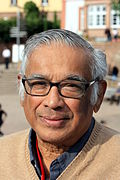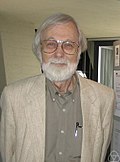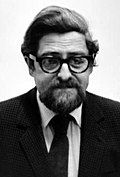Abel Prize
The Abel Prize /ˈɑːbəl/ (Norwegian: [Abelprisen] Error: {{Lang}}: text has italic markup (help)) is a Norwegian prize awarded every year by the Government of Norway to one or more outstanding mathematicians.[1] It is named after Norwegian mathematician Niels Henrik Abel (1802–1829) and modelled after the Nobel Prizes,[2][3][4][5][6][7][8] the award was established in 2001 by the Government of Norway and complements its sister prize in the humanities, the Holberg Prize.
It comes with a monetary award of 6 million Norwegian kroner (NOK) (around €650,000).[9]
Winners
| Year | Laureate(s) | Image | Institution(s) | Citation |
|---|---|---|---|---|
| 2003 | Jean-Pierre Serre | 
|
Collège de France | "For playing a key role in shaping the modern form of many parts of mathematics, including topology, algebraic geometry and number theory."[10] |
| 2004 | Michael Atiyah | 
|
University of Edinburgh | "For their discovery and proof of the index theorem, bringing together topology, geometry and analysis, and their outstanding role in building new bridges between mathematics and theoretical physics."[11] |
| Isadore Singer | 
|
Massachusetts Institute of Technology University of California, Berkeley | ||
| 2005 | Peter Lax | 
|
Courant Institute | "For his groundbreaking contributions to the theory and application of partial differential equations and to the computation of their solutions."[12] |
| 2006 | Lennart Carleson | 
|
Royal Institute of Technology | "For his profound and seminal contributions to harmonic analysis and the theory of smooth dynamical systems."[13] |
| 2007 | S. R. Srinivasa Varadhan | 
|
Courant Institute | "For his fundamental contributions to probability theory and in particular for creating a unified theory of large deviation."[14] |
| 2008 | John G. Thompson | 
|
University of Florida | "For their profound achievements in algebra and in particular for shaping modern group theory."[15] |
| Jacques Tits | 
|
Collège de France | ||
| 2009 | Mikhail Gromov | 
|
Institut des Hautes Études Scientifiques[16] and Courant Institute[17] | "For his revolutionary contributions to geometry."[18] |
| 2010 | John Tate | 
|
University of Texas at Austin | "For his vast and lasting impact on the theory of numbers."[19] |
| 2011 | John Milnor | 
|
Stony Brook University | "For pioneering discoveries in topology, geometry, and algebra."[20] |
| 2012 | Endre Szemerédi | 
|
Alfréd Rényi Institute and Rutgers University |
"For his fundamental contributions to discrete mathematics and theoretical computer science, and in recognition of the profound and lasting impact of these contributions on additive number theory and ergodic theory."[21] |
| 2013 | Pierre Deligne | 
|
Institute for Advanced Study | "For seminal contributions to algebraic geometry and for their transformative impact on number theory, representation theory, and related fields."[22] |
| 2014 | Yakov Sinai | 
|
Princeton University and Landau Institute for Theoretical Physics[23] | "For his fundamental contributions to dynamical systems, ergodic theory, and mathematical physics."[24] |
| 2015 | John F. Nash Jr. | 
|
Princeton University | "For striking and seminal contributions to the theory of nonlinear partial differential equations and its applications to geometric analysis."[25] |
| Louis Nirenberg | 
|
Courant Institute | ||
| 2016 | Andrew Wiles | 
|
University of Oxford[26][27] | "For his stunning proof of Fermat's Last Theorem by way of the modularity conjecture for semistable elliptic curves, opening a new era in number theory."[28] |
| 2017 | Yves Meyer | 
|
École normale supérieure Paris-Saclay | "For his pivotal role in the development of the mathematical theory of wavelets."[29] |
| 2018 | Robert Langlands | 
|
Institute for Advanced Study | "For his visionary program connecting representation theory to number theory."[30] |
| 2019 | Karen Uhlenbeck | 
|
University of Texas at Austin | "For her pioneering achievements in geometric partial differential equations, gauge theory and integrable systems, and for the fundamental impact of her work on analysis, geometry and mathematical physics."[31][32] |
| 2020 | Hillel Furstenberg | 
|
Hebrew University of Jerusalem | "For pioneering the use of methods from probability and dynamics in group theory, number theory and combinatorics."[33] |
| Grigory Margulis | 
|
Yale University | ||
| 2021 | László Lovász | 
|
Eötvös Loránd University | "For their foundational contributions to theoretical computer science and discrete mathematics, and their leading role in shaping them into central fields of modern mathematics".[34] |
| Avi Wigderson | 
|
Institute for Advanced Study |
References
- ↑ "Statutter for Holbergprisen og Nils Klim-prisen". Archived from the original on 2018-12-25. Retrieved 2018-05-20.
- ↑ Robert P. Langlands Is Awarded the Abel Prize, a Top Math Honor. https://www.nytimes.com/2018/03/20/science/robert-langlands-abel-prize-mathematics.html?rref=collection%2Fsectioncollection%2Fscience&action=click&contentCollection=science®ion=stream&module=stream_unit&version=latest&contentPlacement=4&pgtype=sectionfront.
- ↑ Dreifus, Claudia (29 March 2005). From Budapest to Los Alamos, a Life in Mathematics. https://www.nytimes.com/2005/03/29/science/29conv.html?pagewanted=1&th&emc=th.
- ↑ Cipra, Barry A. (26 March 2009). "Russian Mathematician Wins Abel Prize". ScienceNOW. Archived from the original on 29 March 2009. Retrieved 29 March 2009.
- ↑ "Geometer wins maths 'Nobel'". Nature. 26 March 2009. Retrieved 17 October 2012.
- ↑ Foderaro, Lisa W. (31 May 2009). In N.Y.U.'s Tally of Abel Prizes for Mathematics, Gromov Makes Three. https://www.nytimes.com/2009/06/01/nyregion/01nyu.html. Retrieved 17 October 2012.
- ↑ "Abel Prize Awarded: The Mathematicians' Nobel". The Mathematical Association of America. April 2004. Archived from the original on 27 August 2012. Retrieved 4 November 2012.
- ↑ Piergiorgio Odifreddi; Arturo Sangalli (2006). The Mathematical Century: The 30 Greatest Problems of the Last 100 Years. Princeton University Press. p. 6. ISBN 0-691-12805-7.
- ↑ "Google Currency Converter". Retrieved 27 March 2017.
- ↑ "The Abel Prize Laureate 2003". The Norwegian Academy of Science and Letters. Retrieved 23 December 2012.
- ↑ "The Abel Prize Laureate 2004". The Norwegian Academy of Science and Letters. Retrieved 23 December 2012.
- ↑ "The Abel Prize Laureate 2005". The Norwegian Academy of Science and Letters. Retrieved 23 December 2012.
- ↑ "The Abel Prize Laureate 2006". The Norwegian Academy of Science and Letters. Retrieved 23 December 2012.
- ↑ "The Abel Prize Laureate 2007". The Norwegian Academy of Science and Letters. Retrieved 23 December 2012.
- ↑ "The Abel Prize Laureate 2008". The Norwegian Academy of Science and Letters. Retrieved 23 December 2012.
- ↑ "The Abel Committee's Citation 2009". The Norwegian Academy of Science and Letters. Retrieved 9 August 2016.
- ↑ Foderaro, Lisa W. (31 May 2009). In N.Y.U.'s Tally of Abel Prizes for Mathematics, Gromov Makes Three. https://www.nytimes.com/2009/06/01/nyregion/01nyu.html. Retrieved 17 October 2012.
- ↑ "The Abel Prize Laureate 2009". The Norwegian Academy of Science and Letters. Retrieved 9 August 2016.
- ↑ "The Abel Prize Laureate 2010". The Norwegian Academy of Science and Letters. Retrieved 23 December 2012.
- ↑ "The Abel Prize Laureate 2011". The Norwegian Academy of Science and Letters. Retrieved 23 December 2012.
- ↑ "The Abel Prize Laureate 2012". The Norwegian Academy of Science and Letters. Retrieved 23 December 2012.
- ↑ "The Abel Prize Laureate 2013". The Norwegian Academy of Science and Letters. Retrieved 20 June 2013.
- ↑ "The Abel Committee's Citation 2014". The Norwegian Academy of Science and Letters. Retrieved 9 August 2016.
- ↑ "The Abel Prize Laureate 2014". The Norwegian Academy of Science and Letters. Retrieved 26 March 2014.
- ↑ "The Abel Prize Laureates 2015". The Norwegian Academy of Science and Letters. Retrieved 9 August 2016.
- ↑ "The Abel Committee's Citation 2016". The Norwegian Academy of Science and Letters. Retrieved 9 August 2016.
- ↑ The Norwegian Academy of Science and Letters. "Sir Andrew J. Wiles receives the Abel Prize". Press release. http://www.abelprize.no/binfil/download.php?tid=67066. Retrieved 9 August 2016.
- ↑ "The Abel Prize Laureate 2016". The Norwegian Academy of Science and Letters. Retrieved 15 March 2016.
- ↑ "The Abel Prize Laureate 2017". The Norwegian Academy of Science and Letters. Retrieved 21 March 2017.
- ↑ "The Abel Prize Laureate 2018". The Norwegian Academy of Science and Letters. Retrieved 20 March 2018.
- ↑ "Karen Uhlenbeck first woman to win the Abel Prize". The Norwegian Academy of Science and Letters. Retrieved 19 March 2019.
- ↑ Chang, Kenneth (19 March 2019). "Karen Uhlenbeck Is First Woman to Receive Abel Prize in Mathematics - Dr. Uhlenbeck helped pioneer geometric analysis, developing techniques now commonly used by many mathematicians.". The New York Times. https://www.nytimes.com/2019/03/19/science/karen-uhlenbeck-abel-prize.html. Retrieved 19 March 2019.
- ↑ "The Abel Prize Laureates 2020". The Norwegian Academy of Science and Letters. Retrieved 18 March 2020.
- ↑ "The Abel Prize Laureates 2021". The Norwegian Academy of Science and Letters. Retrieved 17 March 2021.